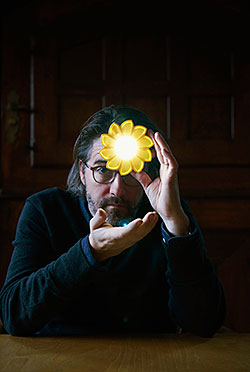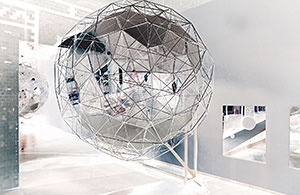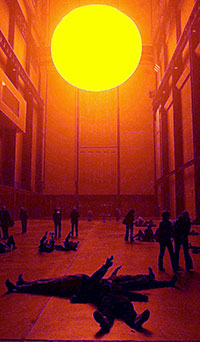Olafur Eliasson at Fondation Louis Vuitton

Simply sign up to the Life & Arts myFT Digest -- delivered directly to your inbox.
Can any artist compete with the combined fantasies of France’s richest man and the world’s most famous architect?
By commissioning Olafur Eliasson, Europe’s philosopher of spectacle, for the inaugural exhibition at his Fondation Louis Vuitton, Bernard Arnault surely wants visual wizardry but also some gravitas, to offset the museum’s rich-man’s-folly image.
With works including “Map for Unthought Thoughts”, a fivefold symmetrically patterned immersive light and mirror installation; “Double Infinity”, a corridor lined with blackened sandpaper; and a rooftop sun-tracker directing rays into Frank Gehry’s building, Eliasson has come up with a show steeped in abstraction. The effects sound so ephemeral that they imply a riposte to the sturdy materialism symbolised by the LV initials carved, jewel-like, over the building’s entrance.
Eliasson says the show, entitled Contact, is “about the horizon that divides, for each of us, the known from the unknown”. So are you an existentialist? I ask the Danish/Icelandic artist when we meet in London ahead of the opening later this month.
“I don’t see myself as a particularly existential person,” Eliasson replies carefully, although he looks the part: solemn, spectacled, floppy-haired, casually dressed in dark trousers and a blue T-shirt bearing the word “Space”.
“Questions about life should be taken in a prosaic manner. Often, ideas don’t come from the inside. And they’re not handed down from God — that’s a romantic notion. They are pragmatic, they come from everyday life, from the gutter of time,” he continues.
It is important, he says, not to mistake an idea for a work of art. “Between an idea and doing something, there’s a bridge. First you make a sketch, it’s a small doodle but it’s amazing, at that moment you have changed the world! Then you might do another drawing, a cardboard model, add colour, put it into a computer, maybe a scientist assists. The assumption in our society is that creativity lies within these choices, between cardboard and wood, red and blue, floor or ceiling, but it doesn’t. It is in the quality of the way it grips the world.”
Eliasson’s installation, “Ice Watch” — huge blocks of ice from Greenland placed outside Copenhagen’s town hall as “a physical wake-up call” to climate change — melted away a few weeks ago. Does he believe that art can transform the world?
He leans forward urgently. “It would be so sad if I said I didn’t believe that. It would be deeming my art to be formalist. But I don’t think the world is easy to change. We talk about climate change or Isis but doing something is much harder. We feel despair and disconnection — no wonder people fall into the hands of nationalism. What makes the cultural sector important is that, unlike the political sector, it enjoys the trust of civic society.”
Most contemporary installation artists, though, enjoy no such thing: from celebrities like Damien Hirst to museum insiders such as Bruce Nauman, Doris Salcedo and Richard Tuttle, they meet with public derision or incomprehension. Eliasson is an exception: his “Weather Project”, with its giant mirrored sun in a misty atmosphere, drew 2m visitors to Tate Modern. It remains the defining image of how 21st-century art can be a focus for social connection, political engagement — its underlying rhetoric was about climate change — and fun. “People lay on the floor, staring up at themselves reflected in that ceiling, lit by the pale yellow light of their new sun god,” critic Robert Hughes applauded.

Participation is a curatorial buzzword but Eliasson’s works, achieving their effects by altering sensory perceptions, then perhaps social or political ones, really do depend on visitors’ responses. “Only once a text has been read, the way it impacts on people reading it — that’s the creative centrifugal force. It’s not a final work, it’s the journey,” he says.
At the LV foundation, that voyage progresses through an enveloping theatre of light and shadows transporting audiences into the apparent darkness of outer space via a reversed water-flow sculpture, “Parallax Planet”, a “Big Bang Fountain” and a glass polyhedron called “Dust Particle”. Like asteroids, visitors will “feel themselves floating through the space, meeting the artworks, meeting other visitors, and seeing them fly by.”
If this is the Nordic romantic sublime reinvented for the space age, it is also informed by Scandinavia’s other ideal: the social contract. “The studio is not a closed unit, it’s an instrumental part of society,” Eliasson insists. “Creativity is about interdependence.” In his studio in Berlin — he commutes there from Copenhagen, where he lives with his art historian wife and their two children, adopted from Ethiopia — Eliasson employs a staff of 90: architects, engineers, technicians, two cooks. The studio’s sustainable vegetarian cookbook was published last year; other philanthropic/business ventures include “Little Sun”, a bright yellow solar-powered LED lamp — £20 at Tate Modern’s shop — whose sale in the west allows its distribution at low prices to parts of Africa without electricity.
Eliasson acknowledges that “having grown up in northern Europe influenced me a lot”, though he adds that “I think of identity as a layering of everything we go through.” Born in Copenhagen in 1967 to Icelandic parents who separated shortly afterwards, he experienced extremes of landscape during holidays in Iceland with his father, “an artist who spent a lot of time in nature, he’d tour around and I’d be with him, but I’d be more interested in making dams.”
Eliasson was “10 days into art school” in Copenhagen in 1989 when “the Wall came down, and we drove at once to Berlin”. He moved there permanently in 1994. “There were not so many artists, 30 or 40 hanging out together. My luck was that when I started there had just been a financial crash, and there was a sudden change from the art of the 1980s to something more ephemeral and psychology-driven.
“I was already very interested in artists of the West Coast, James Turrell, Robert Irwin, and also from New York — Félix González-Torres, Cady Noland, the new sensitivity. We were not even against money, it just wasn’t part of the equation, we didn’t even have a critique against the market.”
It is a long way from there to Arnault’s Fondation Louis Vuitton.
“Some people are sceptical of the involvement of the private sector but it’s wrong to suggest I’m too good to work with the private sector. The better shows, more radical choices, more experimental platforms, are often in the private sector. Don’t underestimate how robust art is.”

Eliasson’s vision — as politician, entrepreneur, studio director, choreographer of rave-like spectacles — is so inclusive that I wonder how his own identity remains in his art.
“It still has a definition of a self. In my case, what constitutes a self is the surrounding’s ability to hold it. When I speak to you now, you’re carrying me, you reflect me.”
In the end, intimacy in Eliasson’s art is about us, not him.
“You encounter yourself through the work,” he says, “It can remind you of something you knew about yourself but had forgotten, something holding unthought thoughts. We know from literature, theatre, how sometimes you recognise yourself in the work: ‘That is exactly how I feel, I just had not come to give that thought a shape.’ That is what culture fundamentally does.”
‘Olafur Eliasson: Contact’, Fondation Louis Vuitton, Paris, December 17-February 16 2015, fondationlouisvuitton.fr
Photographs: Ulf Svane, María del Pilar García Ayensa Studio, Chris Young
Comments